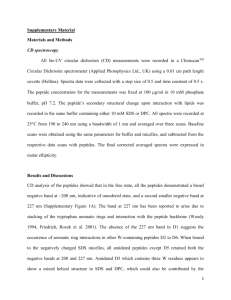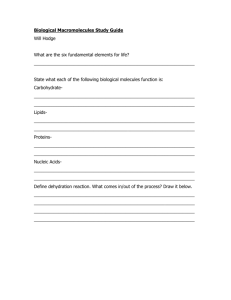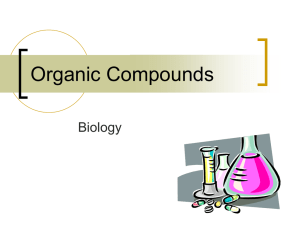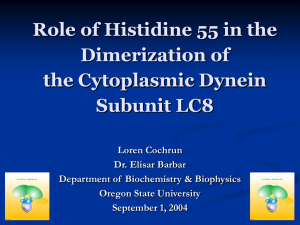(a) determination of the equilibrium constant
advertisement
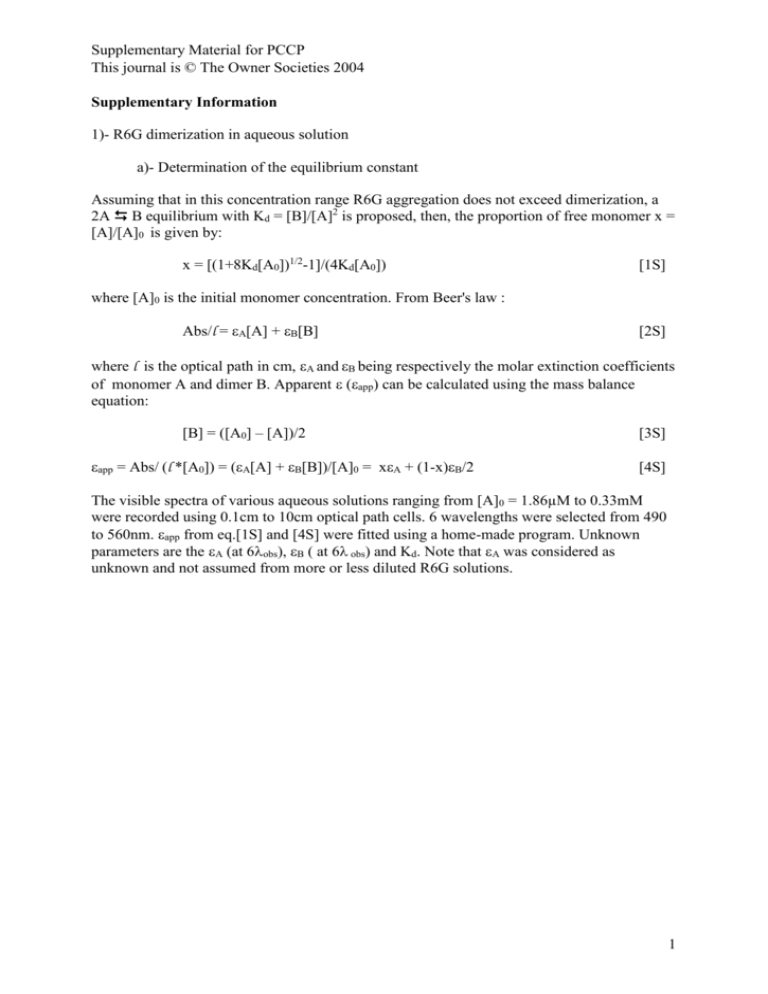
Supplementary Material for PCCP This journal is © The Owner Societies 2004 Supplementary Information 1)- R6G dimerization in aqueous solution a)- Determination of the equilibrium constant Assuming that in this concentration range R6G aggregation does not exceed dimerization, a 2A B equilibrium with Kd = [B]/[A]2 is proposed, then, the proportion of free monomer x = [A]/[A]0 is given by: x = [(1+8Kd[A0])1/2-1]/(4Kd[A0]) [1S] where [A]0 is the initial monomer concentration. From Beer's law : Abs/l = A[A] + B[B] [2S] where l is the optical path in cm, A and B being respectively the molar extinction coefficients of monomer A and dimer B. Apparent (app) can be calculated using the mass balance equation: [B] = ([A0] – [A])/2 app = Abs/ (l *[A0]) = (A[A] + B[B])/[A]0 = xA + (1-x)B/2 [3S] [4S] The visible spectra of various aqueous solutions ranging from [A]0 = 1.86µM to 0.33mM were recorded using 0.1cm to 10cm optical path cells. 6 wavelengths were selected from 490 to 560nm. app from eq.[1S] and [4S] were fitted using a home-made program. Unknown parameters are the A (at 6obs), B ( at 6 obs) and Kd. Note that A was considered as unknown and not assumed from more or less diluted R6G solutions. 1 Supplementary Material for PCCP This journal is © The Owner Societies 2004 5 app. (L.Mol-1.cm-1) 1 10 4 8 10 525 4 6 10 500 490 4 4 10 540 4 2 10 550 560 0 0 -5 5 10 0.0001 0.00015 0.0002 0.00025 0.0003 0.00035 [R6G] (mol.L-1) Figure 1S: Apparent molar extinction coefficients of aqueous solutions of R6G at selected wavelengths. Data points: experiments; lines: numerical fitting from eqs [1S] and [4S]. (nm) A 490 28800 500 39120 525 85040 540 52080 550 20500 560 7230 113600 118600 37740 28280 24830 15900 (L.mol-1.cm-1) B -1 -1 (L.mol .cm ) Table IS: Molar extinction coefficients extracted from the fitting (Kd = 2680 L.mol-1) b)- Reconstruction of the monomer and dimer spectra. Monomer and dimer spectra (A and B/2 vs ) were calculated from the dimerization constants and spectra of two solutions of respective concentrations [A0]1 and [A0]2 . B/2 = (x12 - x21)/(x1 - x2) [5S] A = (1(1- x2) - 2(1 - x1))/(x1 - x2) [6S] where x1 and x2 derive from eq.[1S] for initial concentrations [A0]1 and [A0]2 respectively. 1 and 2 are the corresponding apparent molar extinction coefficients of solutions [A0]1 and 2 Supplementary Material for PCCP This journal is © The Owner Societies 2004 [A0]2 at any wavelength. Better results are obtained by taking [A0]1 and [A0]2 as different as possible. 4 (L.mol-1.cm-1) 8 10 4 6 10 dimer/2 monomer 4 4 10 4 2 10 0 460 480 500 520 540 (nm) 560 580 600 620 Figure 2S: Reconstructed dimer and monomer spectra. c)- Determination of the free monomer content of any solution This calculation is based on the analysis of the shape of the spectrum defined from the ratio of absorbance at two wavelengths and '. From eq. [2S], the following formula can be established which works without the prior knowledge of the total dye concentration. x = (r'B/2 - B/2)/( - r') [7S] where r = Abs/Abs' is the ratio of the spectrum absorbances measured at and ' , = A- B/2 and ' = 'A- 'B/2 respectively at and '. Better results are obtained by taking = 525nm ( max of the monomer) and ' = 500nm ( max of the dimer). From the values listed in Table IS, we have: x = (59300r -18870)/(66170 + 21180r) [8S] 3 Supplementary Material for PCCP This journal is © The Owner Societies 2004 2)- Poisson distribution The fraction of micelles containing i solubilizates is given by the Poisson formula: Pi = (<Q>i)(exp(-<Q>))/i! [9S] where <Q> is the global number of dye molecules per micelles. <Q> = Nagg*[R6G]0/([SDS]0 , Nagg being the mean micellar aggregation number. P0 = fraction of empty micelles = exp(-<Q>), P1 = fraction of micelles containing one dye = <Q>* exp(-<Q>), P2 = fraction of micelles containing two dyes = (<Q>2* exp(-<Q>))/2, P3 = fraction of micelles containing three dyes = (<Q>3* exp(-<Q>))/6, for <Q> < 0.6, higher fractions are negligible. 3)- Ion-pair crystal analysis a)- Optical microscopy Figure3S: Microphotograph of the biggest ion-pair crystal (OVC) ever obtained after aggregation / precipitation at [SDS] 2mM. (170 µm length x 35 µm width). Note the presence of several smaller red dots corresponding to aggregates of radius 1000nm which are likely to correspond to the smaller colloidal crystals (SC). b)- X-ray diffraction spectroscopy 4 Supplementary Material for PCCP This journal is © The Owner Societies 2004 Attempts to obtain crystals suitable for X-ray diffraction experiments have not yet been successful, this the reason why the results obtained by the X-ray diffraction studies of the 1:1 R6G:SDS are not very satisfactory. The crystals form very nice plates, but thicker plates are only formed by overlapping of many layers giving a multi-crystal. We were forced to work with a very thin plate producing only very weak diffraction pattern. But the main features of the structure can be discussed. As represented in Figure 4S(a) (after increasing the asymmetric unit) the structure confirms the 1:1 ratio of the ion pair. The cationic part is even good enough to be represented in thermal ellipsoid style. For two half molecules of the cation two half SO3R anions are present in the asymmetric unit. The high degree of freedom for the positions of the dodecyl groups lead to problems of high disorder. For the moment we are trying to overcome this problem by recrystallization at low temperatures in order to cool the movements of the long chains and to favor certain positions. Furthermore, as represented in Figure 4S(b), the anions and the cations are organized in channels along the b axis. Crystal data: The structure crystallizes in the monoclinic space group P2/m with the cell parameters a = 14.860(8) Å, b = 16.617(9) Å, c = 16.998(9) Å, = 111.47(1)°. We tried P2 and Pm in order to see if some disorder problems are only due to pseudosymmetry, but both space groups show the same problems. For the moment we are blocked at about 0.18 for R1(I>2(I)). (a) (b) 5 Supplementary Material for PCCP This journal is © The Owner Societies 2004 Figure 4S(a) and (b): Semi-refined X-ray diffraction structure of the 1:1 SDS:R6G ion pair microcrystals. 6



